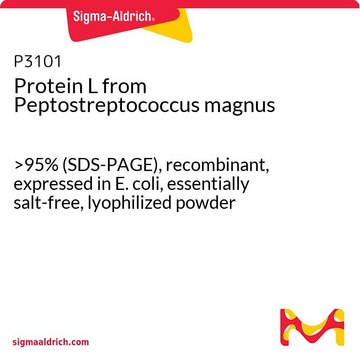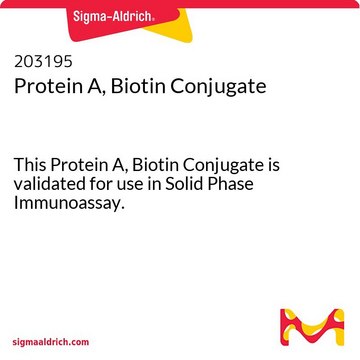P8045
Protein G-Biotin from Streptococcus sp.
recombinant, expressed in unspecified host, lyophilized powder
Synonym(e):
Biotinylated Protein G, Protein G Biotin, Protein G-Biotin
Anmeldenzur Ansicht organisationsspezifischer und vertraglich vereinbarter Preise
Alle Fotos(1)
About This Item
Empfohlene Produkte
Rekombinant
expressed in unspecified host
Qualitätsniveau
Konjugat
biotin conjugate
Form
lyophilized powder
Zusammensetzung
Protein, ~90% biuret
Kennzeichnungsgrad
2-4 mol d-biotin per mol protein
Methode(n)
direct ELISA: 1:70,000 using human IgG
Lagertemp.
2-8°C
Allgemeine Beschreibung
Protein G binds to antibodies reversibly and thus, it is considered in antibody purification. It is a 20 kDa protein.
Protein G is an immunoglobulin (IgG) specific bacterial cell wall protein isolated from Streptococci (group G). Native proteins G consist of two IgG-binding domains and albumin and cell surface binding sites. Biotin is a water soluble vitamin that acts as a coenzyme for carboxylase enzyme reactions. Biotin deficiency results in deregulation of metabolic pathways and various physiological impairments. Biotin deficiency is known to cause birth anomalies indicating its important role in development and differentiation of embryos.
Spezifität
Binds IgG only from most mammalian species except cat; binds chicken IgG.
Anwendung
Protein G-Biotin from Streptococcus sp. has been used during incubation for synergistic immunocapture of antigen which was performed using streptavidin-coated magnetic beads.
Protein G-Biotin from Streptococcus sp. has been used in electrochemical biosensing, for the attachment of antibodies with different specificities.
Verpackung
Package size based on protein content
Sonstige Hinweise
Truncated - lacks albumin, Fab and membrane binding sites.
Angaben zur Herstellung
Prepared using biotinamidocaproate N-hydroxysuccinimide which incorporates an aminocaproyl spacer.
Haftungsausschluss
Unless otherwise stated in our catalog or other company documentation accompanying the product(s), our products are intended for research use only and are not to be used for any other purpose, which includes but is not limited to, unauthorized commercial uses, in vitro diagnostic uses, ex vivo or in vivo therapeutic uses or any type of consumption or application to humans or animals.
Lagerklassenschlüssel
11 - Combustible Solids
WGK
WGK 3
Flammpunkt (°F)
Not applicable
Flammpunkt (°C)
Not applicable
Persönliche Schutzausrüstung
Eyeshields, Gloves, type N95 (US)
Hier finden Sie alle aktuellen Versionen:
Besitzen Sie dieses Produkt bereits?
In der Dokumentenbibliothek finden Sie die Dokumentation zu den Produkten, die Sie kürzlich erworben haben.
Kunden haben sich ebenfalls angesehen
Electrochemical biosensing based on universal affinity biocomposite platforms
Zacco E, et al.
Biosensors And Bioelectronics, 21(7), 1291-1301 (2006)
Ayumi Taniguchi et al.
Journal of nutritional science and vitaminology, 53(6), 457-463 (2008-01-19)
It is well known that biotin deficiency causes morphological anomalies in hatchlings of fowl. An abundance of biotin in the yolk, therefore, is greatly required for maintaining reproductive functions. Although there is growing evidence for the molecular significance of the
Principles of Bacterial Detection: Biosensors, Recognition Receptors and Microsystems: Biosensors, Recognition Receptors, and Microsystem, 21(7), 360-360 (2008)
Pierre-Henri Puech et al.
PloS one, 6(7), e22344-e22344 (2011-07-30)
The rupture forces and adhesion frequencies of single recognition complexes between an affinity selected peptide/MHC complex and a TCR at a murine hybridoma surface were measured using Atomic Force Microscopy. When the CD8 coreceptor is absent, the adhesion frequency depends
Alina Sultanova et al.
Microbiology spectrum, 10(3), e0236921-e0236921 (2022-05-24)
Human herpesvirus-6 (HHV-6) contains two genes (U12 and U51) that encode putative homologues of human G-protein-coupled receptors like CCR1, CCR3, and CCR5. It has been shown that these viral proteins can be expressed on the surface of epithelial and some
Unser Team von Wissenschaftlern verfügt über Erfahrung in allen Forschungsbereichen einschließlich Life Science, Materialwissenschaften, chemischer Synthese, Chromatographie, Analytik und vielen mehr..
Setzen Sie sich mit dem technischen Dienst in Verbindung.












